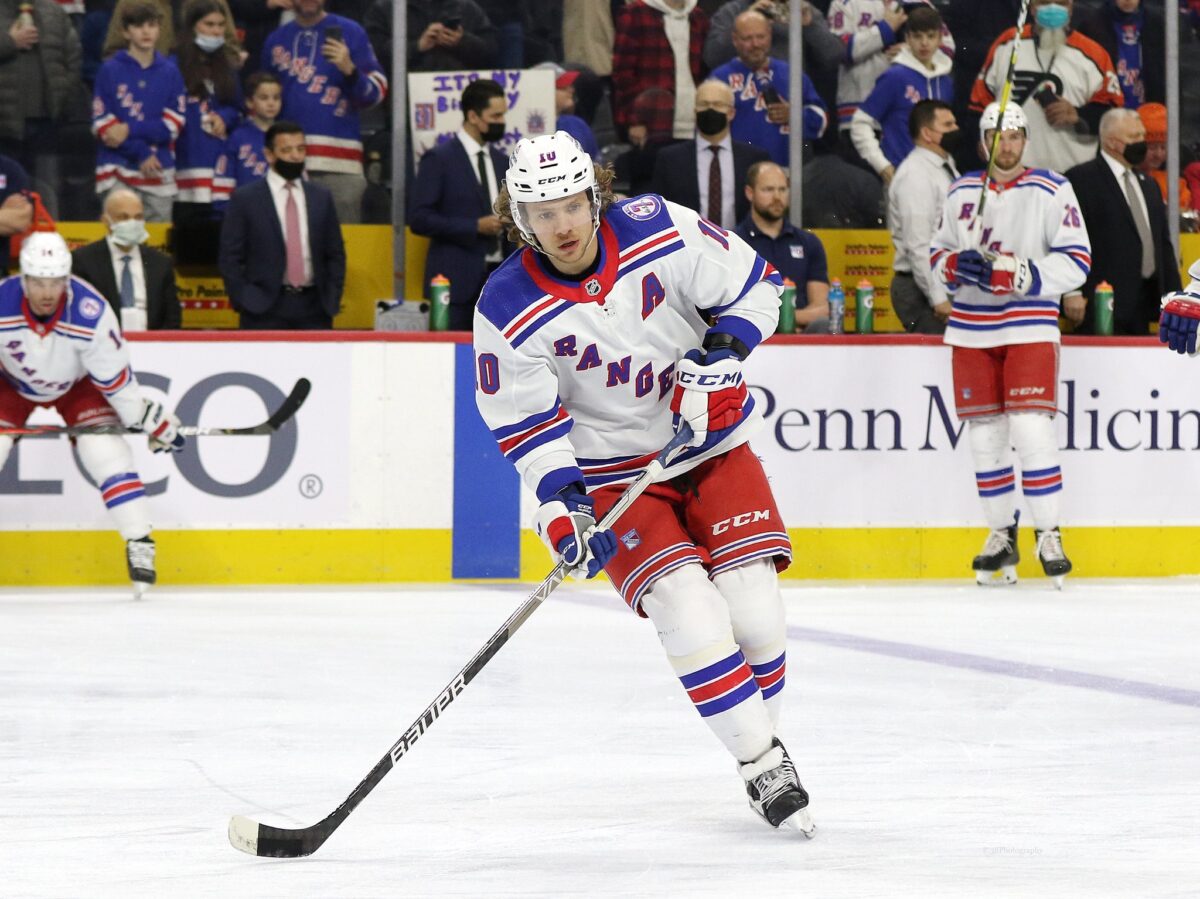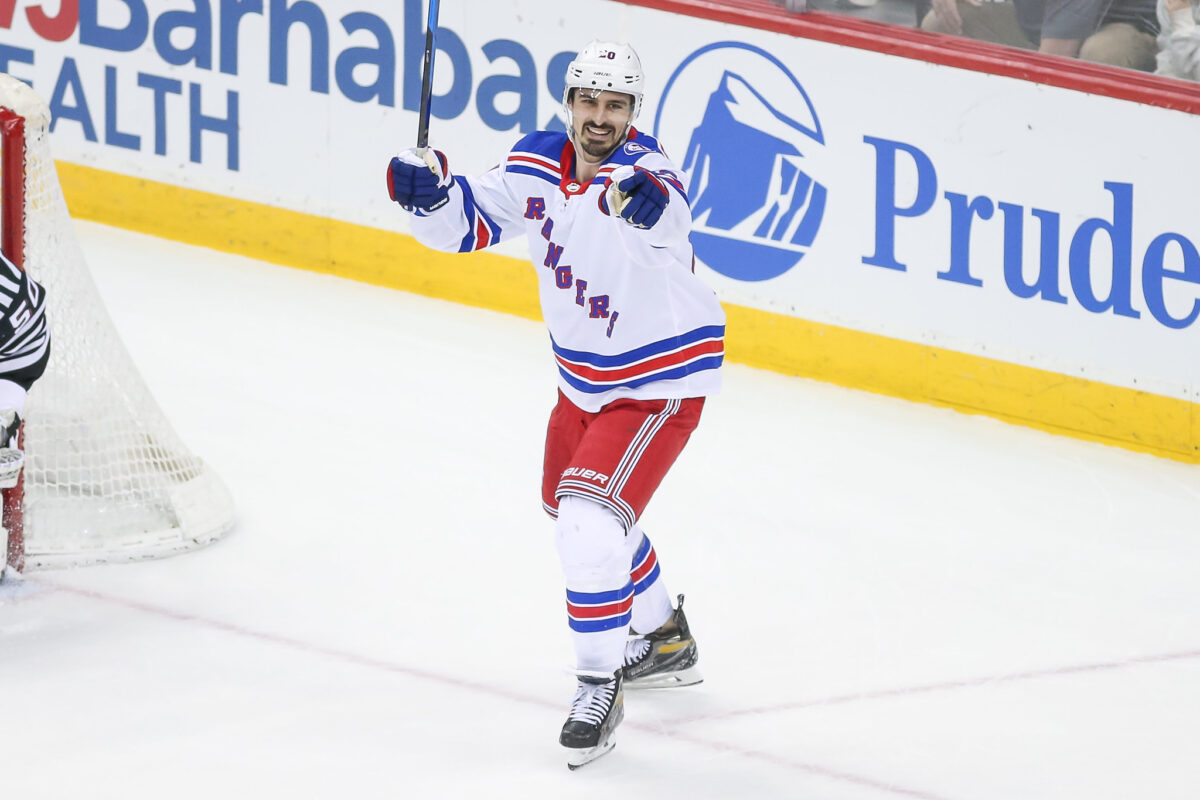Offseason want ad for the New York Rangers:
Seeking versatile second-line center. Looking for 20-25 goals per season, and ability to kill penalties and win faceoffs. Should have track record of driving puck possession and sound play in own end. Must be able to mesh game with highly-creative, puck-dominating linemate. Speed and size preferred, along with comfort at multiple forward positions. Career upside a plus. Salary negotiable.
Know anyone like that, Rangers fans? Well, at least one guy seems to check all of those boxes.
That would be Andrew Copp, the just-turned 28-year-old who’s headed for unrestricted free agency after an outstanding 36-game regular-season and playoff stint on Broadway, one in which his considerable talents were on display in helping the Rangers to within two games of the Stanley Cup Final. Acquired from the Winnipeg Jets for a premium price at the trade deadline, Copp looked like the perfect pickup, reuniting with some old friends already wearing Blueshirts as he fortified the club’s second line for its surprising run to the conference finals.

That has unquestionably driven up the Ann Arbor, Michigan native’s price with free agency set to open Wednesday. Yet his most recent team, though constrained by a tight salary-cap picture, will be taking a serious risk if it allows Copp to get away over a relatively small divide in average annual value.
Copp Proved to Be Perfect Addition to Tight-Knit Rangers
It’s been well-documented how difficult adding a big salary to the payroll will be for general manager Chris Drury this summer. Copp made $3.6 million on a one-year contract last season, and might be in position to nearly double that number in free agency. That’s a place Drury can’t go, not with only about $10 million in space for 2022-23 and Kaapo Kakko needing a new contract this offseason, and fellow restricted free-agents-to-be K’Andre Miller and Alexis Lafreniere due the same next year.
In an ideal world, Drury’s second-line pivot next season would come in at the $5-6 million per range. Copp will cost at least $6-7 million, but if the Rangers could find a way to keep him long-term, they get … well, pretty much everything they’re looking for.
The 6-foot-1, 206-pounder slipped seamlessly into a tight-knit lineup and dressing room after being acquired March 21 for a haul of what became the Rangers’ first-round draft pick in 2022, a conditional second-rounder, forward Morgan Barron and a 2023 fifth-rounder (the Blueshirts also received a sixth-round choice in 2023). A natural center, he easily moved to the right side with center Ryan Strome and left wing Artemi Panarin and excelled.

When Strome was injured in late March and missed four games, Copp stepped back into the middle and recorded two goals and an assist in that stretch, winning 48 percent of his faceoffs.
That final number was actually low for Copp. Though he averaged “only” a 49.6 win rate last season, he finished at between 51.8-55.3 the previous six seasons. The Rangers, who have mysteriously struggled at the dot season after season, need all the help they can get on draws. A player with a 51.9 career percentage certainly qualifies.
Copp further fulfills the Rangers’ Help Wanted ad with his possession-driving skills. He posted a Corsi for percentage of 58.1 in his 16 regular-season games in a Blueshirt and 52.8 in 56 contests with the Jets in 2021-22, giving him his first season over 50 percent. Then there’s his strong penalty killing, with coach Gerard Gallant taking full advantage of Copp’s arrival to deploy him liberally when short-handed, often on the first unit.
Perhaps just as valuable, if not more so, than the rest of his myriad of skills was Copp’s willingness and proficiency at adapting to playing on a line with Panarin, an artist who makes the offensive zone his canvas. Copp, a big, strong, fast-skating center who headmans the puck through the neutral zone and into the opponent’s end, succeeded in adjusting his game to complement the east-west, highly improvisational style of one of the NHL’s best distributors. By the end of the season, the pair was clearly on the same wavelength, Panarin finding Copp for golden scoring chances after the latter had gotten himself into patches of open ice around the net for Panarin to hit with pinpoint passes.
“You just want to figure out where he has the puck, because he has the puck a really large amount of the time in the hockey game,” Copp said in early April. “I want to figure out where he gets that puck and where his head is and where he’s looking for guys.
” … I’m figuring out when (Panarin) wants me to drive the net, when he wants me to pull up, and especially in that left-D, one-timer seam. And kind of coming through that neutral zone, too, he loves the puck on his stick, he loves being dangerous. A lot of the time it’s creating time and space for him.” (From ‘Why The Rangers’ Playoff Hopes May Hinge On The Fit Between Andrew Copp And Artemi Panarin’, New York Post, 4/5/22)
Copp Could Be on the Verge of a Big Leap
What Copp accomplished by becoming a viable wingman for Panarin (or is it the other way around?) in his short time in a Blueshirt also speaks to what kind of teammate he is. Not everyone can play with the Breadman, and not everyone would be so willing to overhaul what’s made them successful for the good of the club – especially with unrestricted free agency looming. It’s probably a safe bet that with the benefit of a full season, the partnership would only become more refined and stronger. After all, Copp was better than a point-per-game player during the regular season on Broadway, with 18 in 16 contests before adding six goals and eight assists in 20 playoff games.
An extended arrangement with Copp looks all the more enticing when one considers the possibility that he might just be coming into his own. Like Rangers teammate Chris Kreider, another big forward who plays with speed and power and blossomed into a 52-goal scorer in 2021-22, Copp could be about to put it all together, with his offensive production possibly set to jump as he enters his prime.

Kreider’s situation probably isn’t a perfect comparison, as Copp just reached the 20-goal mark for the first time this season. Yet his production has been rising along with his ice time, his 21 goals and 32 assists (also a career best) coming after he averaged a career-high 19:11 in 2021-22. This season was the fourth in a row that Copp’s point total and average ice time increased.
The Rangers do have other options to fill the now-vacant spot in the middle behind No. 1 center Mika Zibanejad. Strome, who like Copp figured out how to excel with Panarin during a three-season partnership, is also about to be a UFA and might be willing to sign for close to Drury’s preferred AAV. Filip Chytil, 22 and a similar player to Copp, could be ready to take a big step forward after a breakout performance in the playoffs. There’s also the possibility of signing a free agent, or trading for someone like Copp’s former Jets teammates Pierre-Luc Dubois or Mark Scheifele.
Related: Rangers’ Filip Chytil Must Avoid Alex Kovalev’s Path With Team
Strome, however, doesn’t possess Copp’s diverse toolbox of talents. Chytil, for all his potential, has yet to prove he’s anything more than inconsistent – and again, lacks Copp’s versatility. A high-profile free agent such as Nazem Kadri will almost certainly be unaffordable for the Rangers, and Scheifele and DuBois might cost far too much in a trade.

While DuBois centered Panarin for a time during Panarin’s two seasons with the Columbus Blue Jackets, he’s in line for a big contract as well (he’s set to become an RFA with arbitration rights). It also can’t be assumed that Scheifele, as tantalizing a possibility as he is, would find chemistry with Panarin.
Copp Could Be Leaving His Ideal Situation Behind
No, it’s Copp who seemed the natural fit for the Rangers, providing an instant upgrade to the top-six forward group, the efforts at the faceoff dot and the penalty kill. Playing with childhood friend and University of Michigan and Jets teammate Jacob Trouba along with another Wolverines teammate, Tyler Motte, Trouba looked at home on the ice and with his surroundings.
Copp will test free agency, as a player in his situation should. He deserves to earn as much money as he can. Perhaps the Rangers, though, have at least a modicum of leverage if they’re interested in bringing him back. Does Copp want to start anew, with different teammates, in a situation that might not be as ideal as the one in New York seemed to be for him? Would the chance to stay with pal Trouba, on a rising, Stanley Cup-contending team, with one of the world’s best offensive players on his wing, provoke any consideration within Copp to take a slightly-less lucrative deal to stick around?
The odds at this point probably are against it, considering the riches that will likely be waiting for Copp on Wednesday. The “salary negotiable” is the least attainable part of the want ad. The Rangers are fully prepared for Copp to leave as they explore avenues to replace him. Yet both sides should remember how good the brief union was, how ideal the match appeared to be – and how much better it could become long-term before they both look elsewhere.